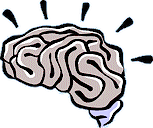 By Dr. Stephen Lundin, Ph.D
By Dr. Stephen Lundin, Ph.D
For my third BrainReady guest Blog contribution, I'd like to follow up on the topic of Association that we discussed in my last piece, expanding to the fascinating area of Synesthesia.
Many of you hopefully gasped in awe if you saw the recent story on the television show 60 Minutes, when Daniel Tammet recited the first 22,514 digits of pi in a five-hour demonstration of his memory capabilities. No, he made no mistakes. Not one digit was out of sequence or forgotten during his continuous five-hour recitation of his memory of the first 22,514 digits of pi, which he had only recently "learned" by simply reading dozens of pages filled with nothing but the numbers themselves.
Most of us have trouble with the telephone numbers of our closest acquaintances.
Daniel, a rare savant who (often unusual for such savants) has the ability to speak and converse with others normally and even eloquently about his incredible mind and abilities, is know as the “Brain Man.”
This short blog is not just about Daniel and his amazing feats; it is also about synesthesia and how you might alter the way you think about your memory abilities.
Daniel described his numbers as having shape, texture and color...rather than "seeing" the digit as merely an isolated numerical entity. He actually feels a positive, emotional, artistic, aesthetic connection to numbers. And groups of numbers. And very large groups of numbers.
These representations are so visual, so aesthetic for Daniel, that certain combinations produce "ugly" images and feelings in his brain, while others produce stunningly, movingly beautiful images for him. His brain is able to synthesize numbers, relations between numbers, and equations with other brain information and senses (in his case, visual and mood-related), all synthesized together and resulting in binary-precise yet aesthetically impressionistic mental images with associated feelings. And these resulting images can be broken down, "played back" and translated into raw digits as we (outside of Daniel's head) know them, all with computer-like accuracy.

This is what the human brain is capable of.
Years ago Tony Buzan, creator of the term "mind mapping", suggested that by "using your senses as a memory tool you will greatly enhance your recall". And I have been doing just that ever since. I don't remember long lists of words or numbers, but rather the things that are more important for me such as key themes in a talk or where I parked my car. I purposely and consciously try to associate feelings, pictures, colors and smells with the items I want to remember, often creating a mental "story".
Synesthesia is not usually used proactively but as a description for something that happens with people like Daniel. But it can be proactive.
And the most amazing part of it for me is that it is actually easier to remember something when you build a number of associations around it. In a sense, remembering more is easier than remembering less when you use the power of association and the principles of synesthesia and association.
Lose your keys. Just connect with the garlic smell, and the rainbow... :)
My next few blogs will be focused on a topic that is near and dear to me: innovation. In September 2007 my book, CATS: The Nine Lives of Innovation will be published in Australia by the Australian Institute of Management and I am going to take you on a tour of the central ideas contained in CATS. Is that all right with you, the BrainReady readers? Feedback welcome.
All the best,
- Steve
